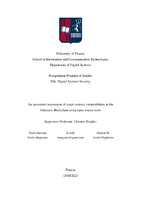| dc.contributor.advisor | Ξενάκης, Χρήστος | |
| dc.contributor.advisor | Xenakis, Christos | |
| dc.contributor.author | Μαγκούτης, Βασίλειος | |
| dc.contributor.author | Magkoutis, Vasilis | |
| dc.date.accessioned | 2023-03-24T10:03:17Z | |
| dc.date.available | 2023-03-24T10:03:17Z | |
| dc.date.issued | 2023-01-15 | |
| dc.identifier.uri | https://dione.lib.unipi.gr/xmlui/handle/unipi/15281 | |
| dc.identifier.uri | http://dx.doi.org/10.26267/unipi_dione/2703 | |
| dc.description.abstract | Η τεχνολογία Blockchain εμφανίζεται σταδιακά στο τεχνολογικό φάσμα και στην ακαδημαϊκή κοινότητα. Από τις διάφορες χρήσεις του blockchain, μία από τις πιο επιτυχημένες και ενδιαφέρουσες είναι η εικονική μηχανή του Ethereum. Σε αυτήν την περίπτωση, το blockchain μπορεί να επιτρέψει σε έξυπνα συμβόλαια (στην ουσία, κώδικα προγραμματισμού) να εκτελούνται στο δίκτυο αυτόνομα. Αυτή η συγκεκριμένη τεχνολογία έφτασε γρήγορα και πολλοί προγραμματιστές ήδη κωδικοποιούν αυτά τα έξυπνα συμβόλαια. Ωστόσο, διάφορα τρωτά σημεία στον κώδικα και τις πρακτικές προγραμματιστών εμφανίστηκαν με την ευρύτερη αποδοχή των έξυπνων συμβολαίων. Σταδιακά έγιναν διαθέσιμα εργαλεία για τον εντοπισμό αυτών των τρωτών σημείων και η κοινότητα επικεντρώθηκε περισσότερο στην ασφάλεια των έξυπνων συμβολαίων. Τι γίνεται όμως με το αποτέλεσμα; Πόσα ευάλωτα συμβόλαια υπάρχουν στο δίκτυο, υπάρχουν συμβόλαια με διαφορετικά τρωτά σημεία και μειώνονται τα ευάλωτα συμβόλαια που αναπτύσσονται στο δίκτυο; Τα παραπάνω αποτελούν μερικά από τα ερωτήματα που θα προσπαθήσουμε να απαντήσουμε. | el |
| dc.format.extent | 56 | el |
| dc.language.iso | en | el |
| dc.publisher | Πανεπιστήμιο Πειραιώς | el |
| dc.rights | Αναφορά Δημιουργού 3.0 Ελλάδα | * |
| dc.rights.uri | http://creativecommons.org/licenses/by/3.0/gr/ | * |
| dc.title | An automated assessment of smart contract vulnerabilities in the Ethereum blockchain using open-source tools | el |
| dc.title.alternative | Μια αυτοματοποιημένη αξιολόγηση ευπαθειών έξυπνων συμβολαίων στο Ethereum Blockchain χρησιμοποιώντας εργαλεία ανοιχτού κώδικα | el |
| dc.type | Master Thesis | el |
| dc.contributor.department | Σχολή Τεχνολογιών Πληροφορικής και Επικοινωνιών. Τμήμα Ψηφιακών Συστημάτων | el |
| dc.description.abstractEN | Blockchain technology is gradually taking place in the technology spectrum and the academic community. From the various uses of the blockchain, one of the most successful and interesting ones is the Ethereum Virtual Machine. In this case, blockchain can enable smart contracts (in essence, programming code) to run on the network autonomously. This particular technology arrived fast, and multiple developers are already coding these smart contracts. However, various vulnerabilities in their code and developer practices surfaced with the broader acceptance of smart contracts. Gradually tools to identify these vulnerabilities became available, and the community focused more on the security of the smart contracts. But what about the result? How many vulnerable contracts exist on the network, are there contracts with different vulnerabilities, and are the vulnerable contracts deployed on the network decreasing? The above constitute some of the questions we will try to answer. | el |
| dc.contributor.master | Ασφάλεια Ψηφιακών Συστημάτων | el |
| dc.subject.keyword | Blockchain | el |
| dc.subject.keyword | Ethereum | el |
| dc.subject.keyword | Vulnerability assesment | el |
| dc.subject.keyword | Smart contracts | el |
| dc.subject.keyword | Oyente | el |
| dc.subject.keyword | Osiris | el |
| dc.subject.keyword | Maian | el |
| dc.subject.keyword | Mythril | el |
| dc.subject.keyword | EVM | el |
| dc.subject.keyword | Ethereum Virtual Machine | el |
| dc.subject.keyword | Reentrancy vulnerability | el |
| dc.subject.keyword | Prodigal vulnerability | el |
| dc.subject.keyword | Callstack vulnerability | el |
| dc.date.defense | 2023-02-27 | |



